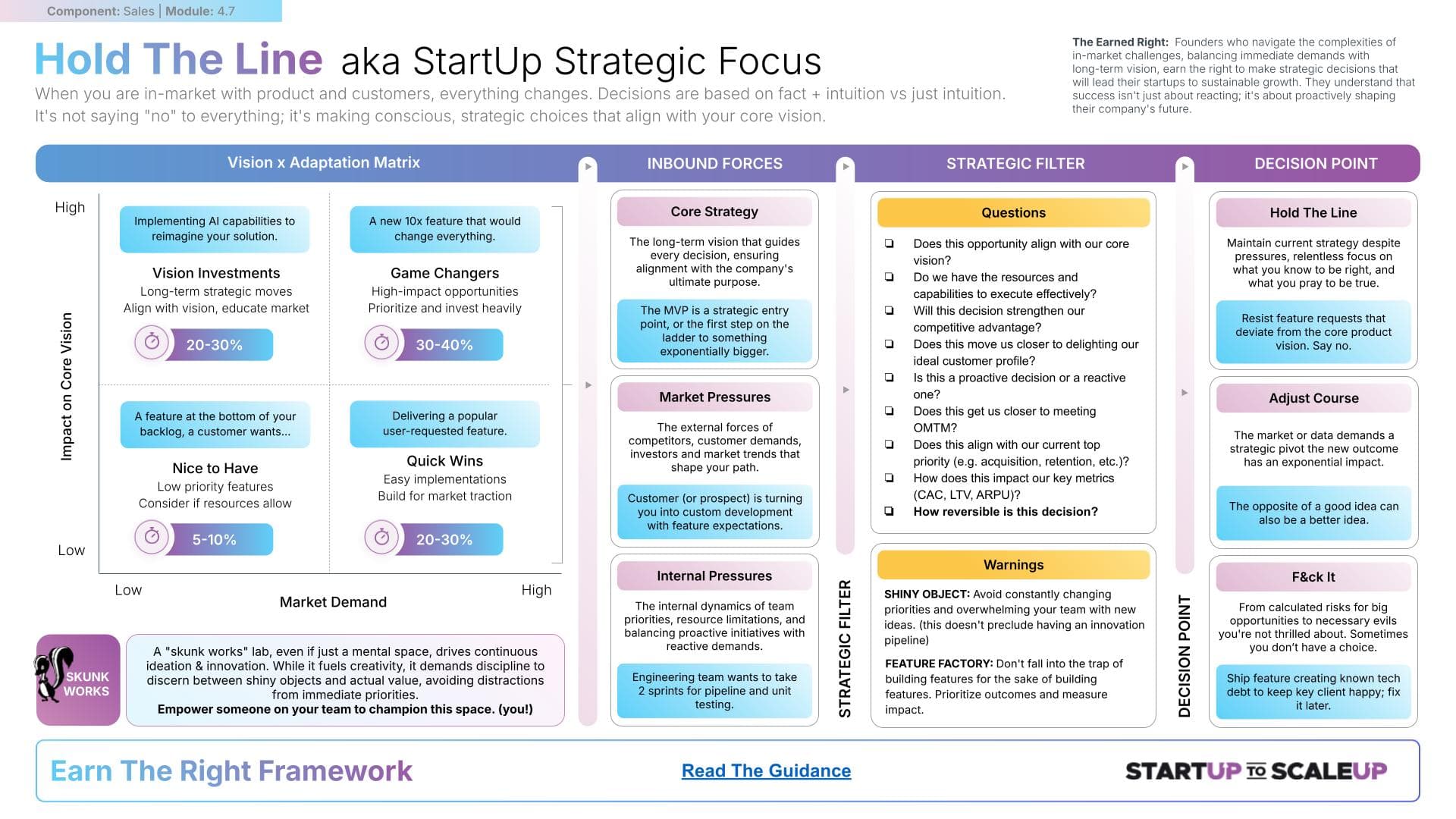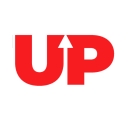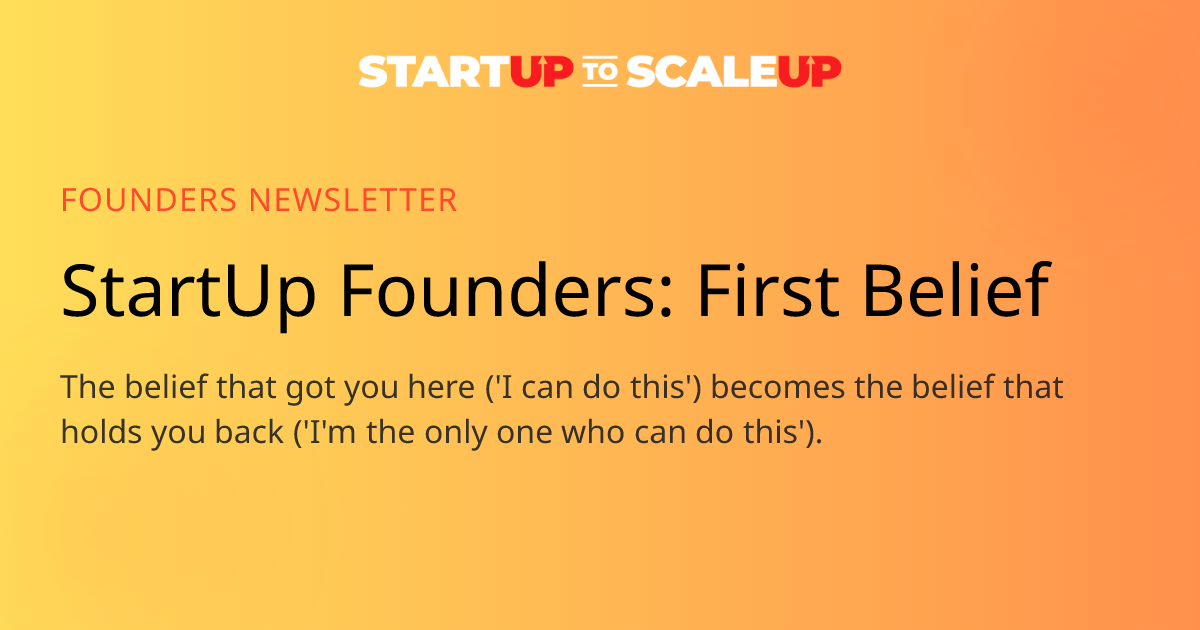Startup Product Strategy: How Founders Balance Vision, Stakeholder Pressure, and Ruthless Prioritization for Long-Term Success
Published September 1, 2024
Core Takeaway
TLDR
- Post-launch, all stakeholders will try to steer your product direction - engineers, sales, customers, and even yourself
- Make decisions based on facts AND intuition rather than just gut feeling, categorizing each choice into strategic quadrants
- Don't become a 'feature factory' - filter ruthlessly by asking if each request aligns with your vision, is executable, and delights your ideal customer
Newsletter
Hey Reader,
Remember when you thought building the product was the hard part? Cute.
The second your product hits the market, a whole new attack sequence starts. Suddenly, everyone's fighting to steer you off course - including yourself.
You're juggling shiny objects, must-have features, demanding customers, and new idea grenades. Straddling sales, product & operations is both your superpower and your kryptonite.
LAST WEEKS FRAMEWORK:
0.2 Traction x Fame Curve: Anywhere But Red (Join Convo)
LETS GET INTO IT:
Most founders, the second they hit market, try to please everyone, chase every "opportunity", and end up building a Frankenstein that in an effort to solve everything for everyone, solves nothing for no one.
Don't be that founder.
Sound familiar? Your engineers want two sprints for technical debt. Your sales team (you) is promising features your prospects want. Engineering wants you to sell what they already built. Your customer that is acting as a reference is demanding a feature. Your internal systems are built with silly string.
The pressure to prioritize growth at all costs can lead to a reactive "feature factory" mindset, where the pursuit of short-term gains overshadows long-term vision and customer-centricity.
And the only metric anyone seems to care about is growth (at least for now).
You have an impossible job that only works if you have the patience, strength, discipline, and resilience to be moderately right about when to maintain course vs. when to make an adjustment.
It's not about stubbornness. It's about being strategic. Knowing when to hold the line and when to pivot. Making conscious choices that align with your vision - not reactionary decisions that turn you into a feature factory.
Navigating The Forces
- Know Your Quadrants: Categorize decisions into Vision Investments, Game Changers, Quick Wins, or Nice to Have. You have to shield against shiny object syndrome.
- Recognize the Forces: Core strategy, market pressures, internal dynamics - acknowledge where the demand is originating, without ceding control.
- Filter Like Your Life Depends On It: Does it align with your vision? Can you execute it? Will it delight your ideal customer? If it's not a hell yes, it's a no.
- Decision Point - Hold or Adjust? Sometimes, holding the line is the bravest move. Other times, a strategic pivot is the only move. Learn to tell the difference.
- Maintain Your Skunkworks: Keep innovating, have an experimentation pipeline, but don't let it derail your main mission.
- Calculated Risks vs. Necessary Compromises: Recognize when a calculated risk is needed to seize an opportunity, and when a compromise, though not ideal, is necessary for the greater good.
You're not here to build features. You're here to solve problems and deliver value (outcomes). Don't let short-term pressures derail your long-term vision. Unless, of course, they absolutely have to...then do whatever it takes.
What Now?
Here's a pro-tip you probably won't do:
Every time a ticket goes from your backlog into sprint, add these 6 fields:
- Date: When the decision was made.
- Decision Made: Concise description.
- Quadrant (Impact/Effort): Categorization based on impact and effort.
- Rationale: Core reasoning behind the decision.
- Expected Impact (Numbers, Not Feelings): Quantifiable anticipated outcomes.
- Review Date (Reckoning): When you'll review the decision's effectiveness.
If you build a feature that 90 days later has not met the expected impact, it's time for a reckoning. Was the rationale flawed? Did the market shift? Did you execute poorly? This honest reflection is where real growth happens.
Why won't you do the pro-tip? You don't actually have the mechanisms in place to be able to measure the impact of a specific feature. You still don't have observability.
This isn't busywork. It's forcing your to ask fair questions about your own decisions.
Stay focused, stay strategic, and for f's sake, hold the line.
-- James
Frequently Asked Questions
More Newsletters
Continue Your Founder Journey
Explore all the resources available to help you build and scale your startup
Startup Frameworks Library
Related Framework

Hold The Line
You’ll learn a founder‑first way to get to proof faster—clear constraints, real signals, and decisions you can defend.
Subscribe to the Newsletter
Join 140,000+ founders getting exclusive strategies, frameworks, and founder stories every Sunday.
Get instant access to the 50-Step Founder Playbook downloaded over 1M times
Presented by




